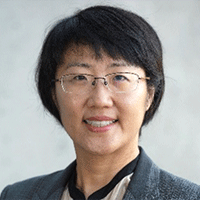
Symposium 1
Ximin He
Associate Professor of Materials Science and Engineering
University of California LA
Los Angeles, CA
Presentation Title: Bio-like Soft Materials with Life-like Intelligence
Abstract: From the cellular level up to the body system level, living organisms present elegant designs to realize the desirable structures, properties, and functions. For example, tendons and muscles are tough but soft, owing to highly complex hierarchical structures rarely found in synthetic materials. Our neuromuscular system enables our motion sensing and response with built-in feedback control, presenting superior intelligence also lacking in manmade systems. Gels, as a class of liquid-laden crosslinked polymer networks, not only have tissue-like water-rich porous networks and can also change their volume and physical properties in response to environmental cues. At UCLA He lab, we exploit fundamental material processing-structure-property-function studies of hydrogels and their derivatives, to create (i) ‘bio-like’ structures and properties and (ii) ‘life-like’ intelligence in functional soft materials for applications in robotics, biomedicine, energy, and environment. This talk will present how these could be realized by mastering polymer-water interactions. Specifically, using classic chemical physical principles to modulate macromolecule assembly up to complex polymer networks, the fundamental limits in mechanical, diffusion and electrical properties could be broken can be broken to design extreme properties. The enabled soft materials featuring high mechanical toughness, ion/electron conduction, fast stimuli response, and "synthetic intelligence" make possible the next-generation energy-self-sufficient robots, personalized medical implants, as well as futuristic smart wearable electronics and battery-powered flight.
Biography: Ximin He is an associate professor of Materials Science and Engineering at University of California, Los Angeles (UCLA) and Faculty of California Nanosystems Institute (CNSI). Dr. He was postdoctoral research fellow in the School of Engineering and Applied Science and the Wyss Institute of Bioinspired Engineering at Harvard University. Dr. He received her PhD in Chemistry at Melville Laboratory for Polymer Synthesis from University of Cambridge. Dr. He’s research focuses on bioinspired soft materials, structural polymers and their physical, mechanical, electrical and photothermal properties with broad applications in biomedicine, energy, environment, and robotics. Dr. He is the recipient of the NSF CAREER award, AFOSR Young Investigator award, CIFAR Global Scholar, SES Young Investigator Medal, International Society of Bionic Engineering (ISBE) Outstanding Youth Award, Advanced Materials Rising Star Award, 3M Non-tenured Faculty Award, Hellman Fellows Award, and UCLA Faculty Career Development Award. Her research on bioinspired tough hydrogels, phototropic, phototaxic, homeostatic and anti-icing materials have garnered a number of regional and international awards and was featured in >100 international news outlets.
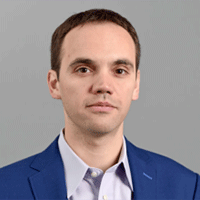
Symposium 1
Konrad Rykaczewski
School for Engineering of Matter, Transport and Energy
Arizona State University
Tempe, AZ
Presentation Title: Adding Solid and Fluids to Liquid Metals: How to Make Multifunctional Liquid Metal Pastes, Foams, and Emulsions
Abstract: Gallium and its eutectic alloys have metallic properties (e.g. high electrical and thermal conductivity) while remaining in liquid state near room temperature. Accordingly, these liquid metals (LMs) are used to make soft and stretchable components and devices for electronics, biomedical, sensor, energy storage, and foremost for thermal management applications. However, the use of the LM is cumbersome because of its rapid oxidation, low viscosity, high surface tension, and reactivity with other metals. These issues can be resolved by adding a variety of solid additives into the LM, which also results in pastes with enhanced properties. Most recently, several routes have also been developed to incorporate secondary fluids into LMs including airto create foams [1,2] and silicone oils to create emulsions[3,4]. Both the foams and emulsions are substantially lighter and easier to apply to surfaces than original LM. In addition, the oil-in-liquid metal emulsions can prevent one of the major drawbacks of gallium and its alloys. Specifically, the emulsion form about 500 nm exterior film that prevents gallium-induced embrittlement of a contacting aluminum surfaces [3,4]. Despite these interesting properties, our understanding of how these LM-based materials form and can be improved on is just beginning to emerge.
In this presentation I will describe the highly intertwined microscale formation mechanisms of LM pastes, foams, and emulsions. First, I will discuss systematic experiments on the internalization of a several sizes and volume fractions of silica microparticles into LM, which demonstrate that some air bubble entrapment always occurs along with particles. Similarly, the experiments demonstrate that addition of solid micro-particles is required for the onset of LM foaming. In other words, there are no pure LM pastes or LM foams but multiphase LM composites with varying volume fractions of solid and air components. The particles size, volume fraction, and mixing method can be used to either promote or inhibit air entrapment leading to more paste-like or foam-like composites. Second, I will discuss formation of the oil-in-LM emulsions. When mixed with any other liquid, pure LM breaks-up into microdroplets. We discovered that this can be prevented when silicone oil is mixed with LM foam. I will discuss how the silicone oil droplets are internalized in the LM foam, and how prior addition of even a small volume fraction of silica particles into LM removes the need for foaming of the liquid before oil addition.
We acknowledge funding from National Science Foundation grant 2034015.
[1] Wang, X., Fan, L., Zhang, J., Sun, X., Chang, H., Yuan, B., Guo, R., Duan, M., and Liu, J., 2019, "Printed Con-formable Liquid Metal E‐Skin‐Enabled Spatiotemporally Controlled Bioelectromagnetics for Wireless Multisite Tu-mor Therapy," Adv Funct Mater, p. 1907063.
[2] Kong, W., Shah, N. U. H., Neumann, T. v, Vong, M. H., Kotagama, P., Dickey, M. D., Wang, R. Y., and Rykaczewski, K., 2020, "Oxide-Mediated Mechanisms of Gallium Foam Generation and Stabilization during Shear Mixing in Air," Soft Matter, 16, pp. 5801–5805.
[3] Shah, N. U. H., Kong, W., Casey, N., Kanetkar, S., Wang, R. Y.-S., and Rykaczewski, K., 2021, "Gallium Oxide-Stabilized Oil in Liquid Metal Emulsions," Soft Matter, 17, pp. 8269–8275.
[4] Shah, N. U. H., Kanetkar, S., Uppal, A., Dickey, M. D., Wang, R. Y., and Rykaczewski, K., 2022, "Mechanism of Oil-in-Liquid Metal Emulsion Formation," Langmuir, 38(43), pp. 13279–13287.
Biography: Konrad Rykaczewski is an associate professor at School for Engineering of Matter, Transport and Energy at ASU. He received his BS (2005), MS (2007) and PhD (2009) in mechanical engineering from the Georgia Institute of Technology. Prior to his appointment at ASU, he was a research scientist at MIT and NRC postdoctoral fellow at NIST.

Symposium 2
Mikhail Shamonin
Ostbayerische Technische Hochschule Regensburg
Regensburg, Germany
Presentation Title: Magnetoactive Elastomers: Extraordinary Properties and Physics of Iron in Rubber
Abstract: The cutting-edge research in the field of magnetoactive elastomers (MAEs), which comprise soft-magnetic particles embedded into a soft polymeric matrix, will be presented. After introducing the concept, an overview of several extraordinary bulk properties and physical phenomena in these smart materials will be given. The "colossal" magnetorheological effect, the "giant" magnetodielectric effect, the "giant" magnetostriction, and the magnetic properties of MAEs will be discussed. The physical origin of these phenomena is attributed to the re-arrangement (changes in mutual positions) of magnetic particles in a mechanically soft polymer matrix in the presence of an external magnetic field. This phenomenon is usually designated as the restructuring of magnetic filler particles. I will discuss possible theoretical approaches to describe significant changes of physical properties of MAEs in external magnetic fields. I will also present multilayered heterostructures comprising a magnetoactive elastomer (MAE) slab and a commercially available piezoelectric polymer multilayer. These multiferroic structures are promising as sensitive low-frequency sensors of magnetic field. It can be expected that the restructuring of the filler should be also "visible" on MAE surface. In this context, recent results on magnetically controllable surface properties of MAEs will be presented. The control of the wettability of non-structured and microstructured magnetoactive elastomers (MAEs) by magnetic field will be demonstrated. Novel approaches to control drop splashing on non-structured and microstructured MAE surfaces will be discussed.
Biography: Mikhail Shamonin studied physics at Lomonosov University in Moscow, Russia and engineering science at Oxford University in the UK. He received his PhD degree in physics from the University of Osnabrück in Germany with a thesis on magneto-optical waveguides. After a short post-doctoral position at the University of Osnabrück, he worked for more than five years as a physicist for a high-tech company (H. Rosen Engineering GmbH) in Lower Saxony in Germany, which business is mainly in research, development, production, and operation of inspection devices for pipelines and other complex technical systems. Since 2002 he has been Professor for Sensor Technology in the Faculty of Electrical Engineering and Information Technology of the Ostbayerische Technische Hochschule Regensburg in Bavaria, Germany. In recent years, his interest has shifted from sensor technology and metamaterials towards smart materials, particularly magnetoactive elastomers and energy harvesting.
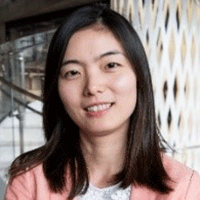
Symposium 2
Yunlan (Emma) Zhang, Ph.D.
Assistant Professor, Department of Civil Architectural and Environmental Engineering
University of Texas at Austin
Austin, TX
Presentation Title: Architected Material Analogs of Shape Memory Alloys
Abstract: Shape memory alloys (SMAs) are smart materials that find applications in areas as diverse as medical devices, endodontic files, and structural dampers for infrastructures. Nevertheless, the widespread use of these materials is limited by their high cost, which is driven by the need for high-purity raw materials and extensive thermo-mechanical processing. Architected materials are another class of emerging materials that usually consist of numerous unit cells. By tailoring the geometry and topology of the unit cells, these materials can exhibit novel and/or customized properties and responses to physical stimuli. Here, we create a type of architected material that can reproduce the novel properties of SMAs which are referred to as Architected Material Analogs of SMAs (ASMAs). ASMAs comprise periodic multistable unit cells and can exhibit both the salient behaviors, superelasticity and shape memory effect of SMAs. ASMAs can be made from a wide variety of polymers, made by many different low-cost production processes as well as 3D printing, and are designed to respond to various stimuli such as heat, magnetic fields, and solvent absorption. ASMAs offer a lower-cost alternative that can expand the design space for SMA-like material behavior to include larger-scale (e.g., seismic resistance device) or lower-cost applications (e.g., medical implants).
Biography: Yunlan Zhang is an Assistant Professor of Civil, Architectural and Environmental Engineering at The University of Texas at Austin. Before she joined UT, she was a Postdoctoral Researcher in the Department of Engineering Science at University of Oxford. She received her PhD and MS degrees in civil engineering from Purdue University in 2019, and her BS in civil engineering from The Ohio State University in 2012. Her research interests include architected materials, deployable structures, and bioinspired design. She wants to combine her knowledge of structures and materials to create advanced structures with applications that range in scale from microscopic medical devices to macroscopic infrastructure retrofits and extraterrestrial habitats. She enjoys working with students just as much as conducting research.

Symposium 3
Jovana Jovanova
Assistant Professor Jovana Jovanova, Ph.D
Faculty of Mechanical, Maritime and Materials Engineering
Delft University of Technology, Netherlands
Presentation Title: Design of Mechanically Intelligent Structures
Abstract: The world we live in is dynamic, continuously changing due to different cyclic or disruptive occurrences. Adaptation of engineering systems to changes, as a feature, has become more valued, even expected, when new designs are developed. Whether it is adapting to operational conditions, people and/or their environment, structures and machines rely on a set of technologies to be able to function in a desired fashion. The complexity of the adaptive function requires model-based design of the interaction between the structure/machines and its operational environment, which requires new modelling approaches to capture this interaction. The advantage of adaptation can be achieved by reducing complexity if the functionality is encoded in the early design of the structures opposed to the traditional way when it is added later in the design process. Encoding functionality in structures during their early design phase is achieved by the combined effort of the geometry and the material property by capturing the flexibility of a structure in large deformation domain and the smart material behaviour. The developed models can also be used for uncovering the scaling rules and the size limits imposed by the material, the geometry and the manufacturing technology. In this talk the idea of mechanically intelligent structures will be presented and discussed, followed by examples of integrating different smart materials (SMAs, hydrogels, piezoelectric materials) in variety of applications for grabbing, soft robotics, multimodal locomotion and energy absorption.
Biography: Jovana Jovanova is assistant professor at the Transport Engineering and Logistics Section, Faculty of Mechanical, Maritime and Materials Engineering, Delft University of Technology in the Netherlands working on the design of large-scale adaptive (meta)structures, mechanisms and machines able to change their properties and/or functionality over time to improve performance, reliability, and efficiency. Adaptation in this context is the ability of structures, mechanisms or machines to recognize the changes occurring in their environment and adjust internally to respond in a desired way. Her research includes analytical, numerical and data-based modelling and characterization of mechanically intelligent structures that utilize smart materials and/or large deformations for adaptation. She integrates concepts of compliant mechanisms, smart materials, metamaterials, bio-inspired design and soft robotics into adaptive machines for the applications in the maritime, offshore and transport technology.
Jovana is involved in TU Delft initiatives within the Robotics and the Bioengineering Institutes, as well as the Dutch Soft Robotics national initiative. She has been an active member of SMASIS since 2016 serving in different Bioinspired TC roles. She has also supported the organization of the Compliant Mechanisms Symposium within ASME IDETC and RoboSoft 2023 conference. She is associate editor at Journal of the Brazilian Society of Mechanical Sciences and Engineering, and Robotics Reports.
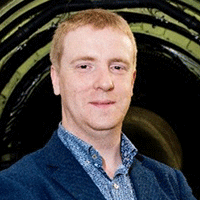
Symposium 4
Roeland De Breuker
Faculty of Aerospace Engineering,
Department of Aerospace Structures and Materials,
Delft University of Technology
Delft, Netherlands
Presentation Title: Smartx: Intelligent Wings Enabling More Sustainable Aviation
Abstract: Making aviation more sustainable means we need breakthroughs in many aeronautical disciplines simultaneously. One of these disciplines is innovative wing design. Such a design can reduce drag and alleviate loads and hence reduce mass. Reduced drag and reduced mass lead to lower energy consumption during flight which reduces greenhouse gas emissions and enables the use of sustainable but lower energy-density energy carriers.
We will present the intelligent wing of the future concept that was developed at the Delft University of Technology within the SmartX project. This wing can sense its own structural and flow state and take autonomous decisions by using nonlinear AI control algorithms to actively change its static and dynamic shape by using distributed morphing control surfaces to reduce drag and alleviate loads.
The SmartX project philosophy and the past, ongoing, and future research activities regarding design and bench, wind tunnel and flight testing will be introduced. Important results that have already been obtained will be presented and discussed, as well as the roadmap for future activities.
Biography: Roeland De Breuker is an associate professor at the Delft University of Technology. He is also Director of Research at the Department of Aerospace Structures and Materials. He specialises in the field of smart and aeroelastic structures. He focuses on developing analysis tools, optimisation and design of structures and related bench and wind tunnel experiments for code validation and proofs of concept. His research activities range from technology readiness levels 1-4. While employed at the Delft University of Technology, he had former experiences with three-month visits to the DLR in Göttingen, Germany and Clarkson University in Potsdam, NY. He was also a visiting professor at Airbus Group Innovations in Munich, Germany, for half a year.
Roeland De Breuker is involved in multiple European and Dutch government-funded projects, as well as industry-funded projects, in the research fields of smart and aeroelastic structures. He is (co-)advising 20 PhD students, he graduated 12 PhD students as (co-) promotor and is advising/has advised over 70 MSc students. He currently holds 58 refereed journal papers and three patents.

Symposium 4
Dr. Francis Phillips
DEVCOM Army Research Laboratory
College Station, TX, USA
Presentation Title: Aeroelastic Analysis of Controls Informed Adaptive Small Unmanned Aerial System
Abstract: The use of small unmanned aerial systems (sUAS) has expanded dramatically over the last decade. These systems can be used for many applications ranging from communications to bridge inspections, agriculture, payload transport, firefighting, meteorology, and beyond. The low cost and low risk nature of sUAS has enabled the testing of various types of adaptive structures which may enable significant performance enhancements including maneuverability, range, and endurance. These adaptive structures may lead to changes in various physical aspects of the vehicle including variable wing camber, twist, sweep, and span. A specific example of utilizing an adaptive structure for sUAS can be found through the Powerline Unmanned Surfer concept which uses novel integrated design strategies in structure, aerodynamics, and controls to extend the flight time. While it is necessary to predict the impact of these adaptive structures on the aerodynamic and control properties of these aerial vehicles, it is also vital to understand the inverse relationships of how aerodynamic and controls will impact the elastic deformation of these active structures. In this talk, the uncoupled static aeroelastic analysis method is presented along with various augmentations for its use in integrated, adaptive structures via the inclusion of an adaptation parameter to correspond with the level of adaptivity required by the controller. Key results including the analysis of wings with either variable wing-span or thickness will be presented. By integrating results from the uncoupled static aeroelastic analysis method into the flight controller, it is possible to better predict the performance of adaptive sUAS.
Biography: Dr. Francis Phillips currently works as a research aerospace engineer for the US Army DEVCOM Army Research Laboratory, where he leads a program focused on development of reconfigurable aerial vehicles including exploring the application and control of active materials to enable reconfiguration as well as aeroelastic analysis coupled to design for reconfigurable vehicles. Prior to joining the Army Research Laboratory, he earned his Ph.D. in Aerospace Engineering from Texas A&M University studying the fatigue of shape memory alloys. Dr. Phillips’ areas of interest include smart materials, reconfigurable structures, and aeroelasticity.
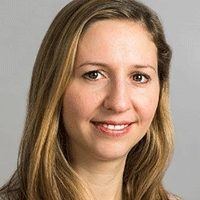
Symposium 5
Tanya Hutter
The University of Texas at Austin
Austin Texas
Presentation Title: Smart Materials and Devices for Sensing and Degradation of Toxic Gases
Abstract: Indoor and outdoor air quality is extremely important for health. Detection and measurement of volatile organic compounds (VOCs) is of great importance for many applications including air quality, industrial monitoring, and medical diagnostics.
Commercially available low-cost sensor technologies are either only capable of measuring a single gas, or only provide a total VOC concentration without ability to differentiate between them. We present a new approach for improving selectivity based on temporally resolved thermal desorption of VOCs from a nanoporous material, which can be combined with any existing VOC detector. An example of a detection system using a commercial total VOC photoionization detector and a nanoporous silica preconcentrator demonstrates several different VOCs and shows potential for discrimination between them.
In the second part of the talk, I will discuss materials for photocatalytic degradation of volatile organics. Most photocatalytic methods use ultraviolet light, however catalyst materials that perform under visible light could be used as an effective approach for improving indoor and outdoor air quality and reducing the health risks associated with exposure to VOCs. Our study investigates the use of visible light and plasmonic gold nano island-enhanced anatase TiO2 as a photocatalyst, and the efficiency of the photocatalysis is evaluated as a function of various fabrication parameters.
Biography: Dr. Tanya Hutter is an Assistant Professor in the Walker Department of Mechanical Engineering at the University of Texas at Austin. She has a B.Sc. in Chemical Engineering (Ben-Gurion University), M.Sc. in Materials Science and Engineering (Tel-Aviv University) and Ph.D. in Physical Chemistry (University of Cambridge). Since completing her Ph.D., she worked as a Research Fellow in Physical Chemistry at the University of Cambridge and received several prestigious fellowships to develop her independent research. In 2016, she was awarded L'Oréal-UNESCO for Women in Science Fellowship UK & Ireland for her scientific achievements.
Her research interests lie in the fields of emerging molecular sensing technologies, nanomaterials, microfabrication and nanophotonics with applications in environmental and industrial sensing, homeland security and medical diagnostics. Dr. Hutter published over 40 peer-reviewed papers and is an inventor on six patents. Dr. Hutter also has a strong interest in technology commercialization and entrepreneurship. Alongside her academic career she co- foundered two startups in the fields of nanophotonic sensing and MedTech.

Symposium 5
Roozbeh Jafari
Tim and Amy Leach Professor
Texas A&M University
Presentation Title: Digital Medicine for Cardiovascular Health
Abstract: The bold vision of pervasive physiological monitoring, through proliferation of off-the-shelf wearables that began a decade ago, has created immense opportunities for precision medicine outside clinics and in ambulatory settings. Although significant progress has been made, several unmet needs remain; Limited availability of advanced wearable sensing paradigms, noise and missingness in wearable data and labels in ambulatory settings, the unknown circumstances surrounding data capture in wearable paradigms, heterogeneity of the users both in terms of physiological and behavioral states, and often limited view into the user's physiological state prevent extraction of actionable information.
This seminar presents several topics that coherently articulate on the vision and the opportunities of digital medicine for cardiovascular health. The seminar covers three pillars of digital medicine, i) sensing, ii) signal processing and iii) context aware and personalized AI as it pertains to cardiovascular health. We will introduce several novel sensing paradigms using bio-impedance that leverage various types of electrodes and electronic tattoos enabling blood pressure measurement with clinical grade accuracy. We will discuss the notion of particle filters that provide a generalizable and robust paradigm for reducing the impact of noise. Finally, we will discuss the concept of digital twin for cardiovascular health, that will enhance the ability to extract actionable information in the context of several real-world applications.
Digital medicine and wearables will play a significant role in the future of medicine outside clinics. The future directions present opportunities both in short-term translational research efforts with direct influence on clinical practice as well as long-term foundational development of theories and computational frameworks combining human physiology, physics, computer science, engineering, and medicine, all aimed at impacting the health and wellbeing of our communities.
Biography: Roozbeh Jafari is the Tim and Amy Leach Professor at Texas A&M university with appointments in School of Engineering Medicine in Houston TX and College of Engineering in College Station, TX. His appointments span over Electrical and Computer Engineering, Biomedical Engineering, Computer Science and Engineering departments. He received his Ph.D. in Computer Science from UCLA and completed a postdoctoral fellowship at UC-Berkeley. His research interest lies in the area of wearable computer design and signal processing. He has raised more than $86M for research with $23M directed towards his lab. His research has been funded by the NSF, NIH, DoD (TATRC), DTRA, DIU, AFRL, AFOSR, DARPA, SRC and industry (Texas Instruments, Tektronix, Samsung & Telecom Italia). He has published over 200 papers in refereed journals and conferences. He has served as the general chair and technical program committee chair for several flagship conferences in the areas of wearable computers. Dr. Jafari is the recipient of the NSF CAREER award (2012), IEEE Real-Time & Embedded Technology & Applications Symposium best paper award (2011), Andrew P. Sage best transactions paper award (2014), ACM Transactions on Embedded Computing Systems best paper award (2019), William O. and Montine P. Head Memorial research award for outstanding engineering contribution award from the College of Engineering at Texas A&M (2019), dean of engineering excellence award at Texas of A&M University (2021) and TEES research impact award at Texas A&M University (2021). He has been named Texas A&M Presidential Fellow (2019). He serves on the editorial board for the Nature Digital Medicine, IEEE Transactions on Biomedical Circuits and Systems, IEEE Sensors Journal, IEEE Internet of Things Journal, IEEE Journal of Biomedical and Health Informatics, IEEE Open Journal of Engineering in Medicine and Biology and ACM Transactions on Computing for Healthcare. He is currently the chair of the IEEE Wearable Biomedical Sensors and Systems Technical Committee (elected) as well the IEEE Applied Signal Processing Technical Committee (elected). He serves on scientific panels for funding agencies frequently, served as a standing member of the NIH Biomedical Computing and Health Informatics (BCHI) study section (2017-2021), and was the inaugural chair of the NIH Clinical Informatics and Digital Health (CIDH) study section (2020-2022). He is a Fellow of the American Institute for Medical and Biological Engineering (AIMBE).
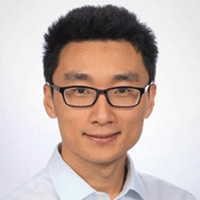
Symposium 5
Peng "Patrick" Sun, Ph.D.
Assistant Professor, Department of Civil, Environ., & Constr. Engr.
University of Central Florida
Orlando, FL
Presentation Title: UAV-based Remote Sensing for Municipal Solid Waste Landfill Inspection and Monitoring
Abstract: Municipal solid waste (MSW) landfills need regular management and maintenance to ensure proper operations and meet the environment protection requirements. One requirement is to monitor landfill gasses (LFGs) which emit from landfill cover into the environment contributing to the global warming. While another requirement is to monitor the potential settlement on MSW landfill covers for maintenance purposes. Surveying tasks are needed to be performed regularly (e.g., quarterly) that are time and labor consuming. Therefore, there is a need for an efficient method to monitor landfill surface conditions. Unmanned aerial vehicles (UAVs) were usually adopted in LFGs emissions and perform landfill surveys as individual tasks and few studies have been reported to achieve multiple UAV surveying tasks synergically. In addition, the automatic detection of water ponding issues yet remains to be studied which may cause water infiltrations. Hence, the study proposes a UAV-based sensing approach and data collection/analysis method to monitor landfill and detect water ponding issues using multimodal sensor fusion. The proposed approach has been applied on a MSW landfill before and after Hurricane Ian which passed near the study location in Florida. The comparative study between the proposed ponding index map and the manual survey shows a satisfactory performance.
Biography: Dr. Patrick Sun is an Assistant Professor in Structural Engineering and Smart Cities in the CECE department and Director of Resilient Infrastructure Sensing and Evaluation (RISE) Laboratory at the University of Central Florida since 2020. Prior to his appointment at UCF, he obtained his PhD from Rice University and postdoc training from the University of Michigan. He is a passionate researcher for smart sensors and sensing systems, in which he incorporates his scientific and engineering understanding of built environment and people. Now he expands his research into UAV-based remote sensing and its applications in environmental engineering and water resource engineering.
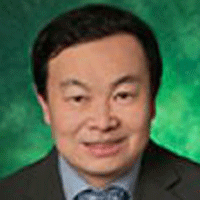
Symposium 5
Haifeng Zhang
University of north Texas
Denton, TX
Presentation Title: Surface Acoustic Wave Quartz Resonators for Nondestructive Structural Monitoring of Nuclear Spent Fuel Canisters by Measuring Internal Pressure at Elevated Temperature
Abstract: A nondestructive method of monitoring the internal pressure of spent fuel canisters is desired for structural monitoring at high-temperature and radioactive environments. Surface Acoustic Wave (SAW) sensors are ideal for use in such hostile situations. In this work, a method for nondestructively monitoring the pressure inside a cylindrical canister using SAW resonators was developed. A prototype of the canister was fabricated for laboratory-level experiments, and a SAW resonator was mounted to the prototype’s outside surface. The internal pressure creates hoop strain on the cylinder’s outer surface, which strains the attached SAW substrate and affects its resonance frequency. Finite element simulations were used to estimate the hoop strain developed on the outer surface of the prototype. The SAW sensor was calibrated by comparing the frequency shift in the resonance frequency to various internal pressures. Initially, a strain gauge was used to calibrate the sensor on a cantilever. Then, the procedure was validated experimentally on a pressurized canister prototype at room temperature. A sensitivity of -30 Hz/kPa was obtained for the SAW sensor attached to the cylinder. Finally, the test was repeated at higher temperatures (up to 60°C) to investigate the sensor’s temperature dependency, and a temperature compensation approach was used for reliable pressure reading at higher temperatures.
Biography: Haifeng Zhang is a Professor of the Department of Mechanical Engineering at the University of North Texas (Denton, TX). His research interests include advanced sensors, energy harvesters, structural health monitoring and ultrasonic nondestructive evaluation. He received his B.S. in Engineering Mechanics from Hunan University, China in 1997, his M.S. degree in Solid Mechanics from Northwestern Polytechnical University, Xian, China, in 2001, and his Ph.D. degree in Engineering Mechanics from University of Nebraska, Lincoln in 2007. He was a postdoctoral researcher in the Department of Material Science and Engineering in the Ohio State University before joining in University of North Texas in 2008. Dr. Zhang is the committee member of ASME energy harvesting technical committee.

Symposium 6
Ankur Mehta
University of California Los Angeles
Los Angeles, CA
Presentation Title: Materials to Makers
Abstract: Robots are pretty great--they can make some hard tasks easy, some dangerous tasks safe, or some unthinkable tasks possible. And they're just plain fun to boot. But how many robots have you made, or even interacted with recently? And where do you think that puts you compared to the rest of the world's people?
In contrast to computation, automating physical interactions continues to be limited in scope and breadth. I'd like to change that. But in particular, I'd like to do so in a way that's accessible to everyone, everywhere, letting more people in to the engineering conversation. In our lab, we work to lower barriers to the design, creation, and operation of mechanical machines—from material and mechanism design, through mathematical analysis, to computational frameworks and tools.
We start from everyday materials such as paper and string, forming them using broadly available tools and infrastructure. By understanding and applying—sometimes in surprising and non-traditional ways—the material properties of these 2D and 1D substrates, we realize mechanisms with non-trivial responsive behaviors. And by composing these mechanisms, we develop a process to design and build robots without a state-of-the-art engineering or manufacturing facility.
With these efforts, we hope to widen the circle of makers, enabling everyone with an idea and an interest to create and enjoy the benefits of custom robotics to work, to learn, and to play.
Biography: Now, this is a story all about how my life took me to where I am now, and I'd like to take a minute--just sit right there—I'll tell you how I became a prof at UCLA. From East Pennsylvania, born and raised, MIT is where I spent the next of my days; getting my Masters and Bachelor's too—ECE is the field I did then pursue. Then a couple of years until I finally would from California, Berkeley get my doctor hood; I got in one little postdoc at MIT CSAIL, and then I moved to LA just south of Bel Air.
Prof. Ankur Mehta is an assistant professor of Electrical and Computer Engineering at UCLA and directs the Laboratory for Embedded Machines and Ubiquitous Robots (LEMUR). Pushing towards his visions of a future filled with robots, his research interests involve printable robotics, rapid design and fabrication, control systems, and multi-agent networks. He has received the DARPA Young Faculty Award, NSF CAREER award, and a Samueli fellowship; he has also received best paper awards in the IEEE Robotics & Automation Magazine and the International Conference on Intelligent Robots and Systems (IROS).
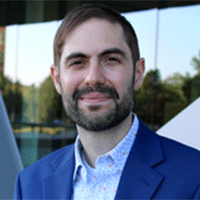
Symposium 6
Jason Patrick, PhD
Assistant Professor
Department of Civil, Construction and Environmental Engineering
North Carolina State University
Raleigh, NC
Presentation Title: Sustained Self-healing of Fiber-reinforced Polymer Composites via in situ Thermal Remending
Abstract: Fiber-reinforced polymer (FRP) composites are attractive structural materials due to their high specific strength/stiffness and excellent corrosion resistance. However, the lack of through-thickness reinforcement in laminated composites creates inherent susceptibility to fiber-matrix debonding (i.e., interlaminar delamination). This multi-scale damage mode has proven difficult to detect and nearly impossible to repair via conventional methods, and thus remains a significant factor limiting the reliability of laminated composites in lightweight structures. An emerging class of synthetic self-healing polymers and composites possess property-retaining functions with the promise of longer lifetimes. But prolonged in-service repair of structural fiber-reinforced composites remains unfulfilled due to material heterogeneity and thermodynamic barriers in commonly cross-linked polymer-matrix constituents. Overcoming these inherent challenges for mechanical self-recovery is vital to extend in-service operation and attain widespread adoption of such bioinspired structural materials.
In this talk, I will describe the recent development of a new self-healing FRP composite platform1,2 based on thermally-induced dynamic bond re-association of 3D-printed polymer interlayers. In contrast to prior thermal remending approaches, self-repair of delamination occurs in situ via resistive heating and below the glass-transition temperature of the thermoset matrix, thereby maintaining elastic modulus during repair. Rapid (minute-scale) and sustained (100+) self-healing cycles have been achieved with fracture recovery reaching 100% of the interlayer toughened composite. Moreover, This latest self-healing advancement in both glass- and carbon-fiber composites exhibits unprecedented potential for prolonged in-service repair along with material multi-functionality (e.g., deicing ability), thereby enabling application versatility.

References
[1] Snyder, A.D., Phillips, Z.J., Turicek, J.S., Diesendruck, C.E., Nakshatrala, K.B., & Patrick, J.F., Prolonged in situ self-healing in structural composites via thermo-reversible entanglement, Nature Communications, 13:6511 (2022).
[2] Patrick, J.F., & Snyder, A.D., U.S. Patent No. 11,618,088 – Self-healing interlaminar delamination in fiber-reinforced composites via thermal remending. Issued: 28 Mar. 2023
Biography: Jason Patrick is an Assistant Professor in the Department of Civil, Construction, and Environmental Engineering with a courtesy appointment in Mechanical and Aerospace Engineering at NC State University. He obtained his Ph.D. in Structural Engineering from the University of Illinois Urbana-Champaign and was a post-doctoral fellow at the Beckman Institute for Advanced Science and Technology before becoming faculty. Prof. Patrick has 20+ years of experience in R&D of advanced fiber-reinforced polymer composites with ongoing federally funded research projects by the DoD and NSF. Research in Dr. Patrick’s group is directed toward the understanding and development of bioinspired material systems that exhibit multi-functionality for enhanced performance, reliability, and longevity. Jason has made significant contributions to the field of multifunctional materials, being a pioneer in self-healing composites, including co-inventing the vaporization of sacrificial components (VaSC) process to create complex internal microvasculature and recently patenting the first self-healing composite laminates with in situ repair capacity via thermal remending. Prof. Patrick has a passion for education and mentoring students while also being driven by research translation where he is the President and Chief Technology Officer (CTO) of the start-up company Structeryx, Inc.
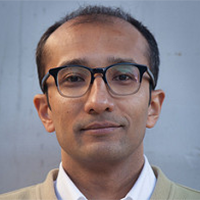
Symposium 7
Jayant Sirohi
University of Texas at Austin
Austin, Texas
Presentation Title: Harvesting Energy from Aeroelastic Instabilities
Abstract: Aeroelastic Instabilities lead to large amplitude oscillatory motion or deformation in a structure, eventually resulting in failure. These instabilities can occur in atmospheric flight vehicles, vehicles that operate in water, and civil engineering structures such as buildings, lamp posts and bridges. Therefore, the conditions at which these instabilities occur are generally to be avoided. However, large amplitude oscillations also present an opportunity for energy harvesting. Aeroelastic instabilities arise when the net effective damping of the coupled fluidstructure system becomes negative, that is, the incident fluid continually adds energy to the structural motion. At the same time, energy harvesting serves to extract energy from the structure, effectively adding damping to it. Combining these two concepts, harvesting energy from a structure in an incident fluid stream that is prone to aeroelastic instability has the added benefit of stabilizing the structure by increasing the net damping of the system. This lecture will present the basic physical phenomena responsible for several well-known aeroelastic instabilities such as galloping and flutter. The fundamental concepts of harvesting energy from a structure using active materials such as piezoceramics will also be explained. These two seemingly disparate fields will then be brought together, illustrating methods to harness the aeroelastic instability and extract energy. Prototype devices along with a few possible applications will be presented. The role of structural nonlinearities in enhancing the energy extracted will be discussed.
Biography: Jayant Sirohi is a Professor in the Department of Aerospace Engineering and Engineering Mechanics at the University of Texas at Austin. He got his PhD in Aerospace Engineering in 2002 and was an Assistant Research Scientist at the University of Maryland, College Park from 2002-2007. During this time, he worked on numerous projects related to Smart Structures and Rotary-wing Micro-Aerial Vehicles. During 2007-2008, Dr. Sirohi worked at Sikorsky Aircraft Corporation, where he was a Staff Engineer in the Advanced Concepts group. At Sikorsky, he was the Technical Lead on analytical and numerical tools for conceptual design. Dr. Sirohi joined UT Austin in 2008 and has been working on Rotary-wing experimental aeromechanics, Smart Structures, plasma flow control and aeroelasticity. His research group specializes in experimental techniques for structural dynamics and aerodynamics, such as Digital Image Correlation and Particle Image Velocimetry, as well as the aeromechanics of rotary-wing aircraft. The contributions of his research group have been acknowledged by several best paper awards, including the ASME/Boeing award (2011) and in conferences by the VFS (2017, 2018), AIAA (2019) and SEM (2019). He is a member of ASME, SEM and VFS, an Associate Fellow of AIAA, and a Technical Fellow of the Vertical Flight Society. In 2017, he was the Technical Chair of the AHS 73rd Annual Forum. In 2019, he was awarded the Friedrich Wilhelm Bessel award by the Alexander von Humboldt foundation.